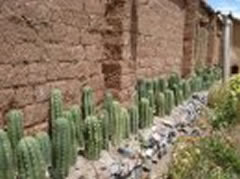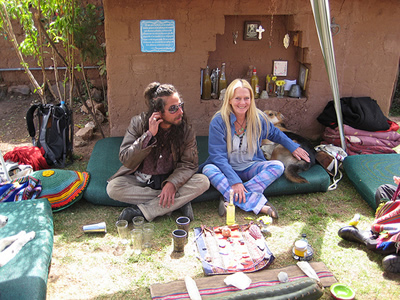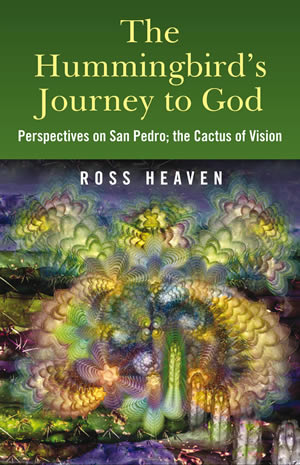Positive Health Online
Your Country

Is San Pedro A 'Miracle Healer'?
listed in healing, originally published in issue 163 - October 2009
The Western world is increasingly familiar with ayahuasca, the visionary brew and 'plant doctor' of Amazonian shamans, thanks to celebrities like Sting and Madonna who have drunk it and television programmes such as Bruce Parry's Tribe and Amazon, which showed the presenter drinking ayahuasca in the jungles of Peru, during which he experienced, he said, some of the most profound insights of his life.[1]
Scientific studies carried out by Western doctors have also demonstrated the effectiveness of ayahuasca in curing illnesses which orthodox medicine finds it hard to address. Especially impressive is its ability to help people overcome drug and alcohol addictions, with a success rate of 70% through the use of ayahuasca alone.[2]
Less well-known – but no less effective – is another of Peru's visionary healing plants: San Pedro. Like ayahuasca, it has been drunk for thousands of years in shamanic healing ceremonies and through it there are said to have been a number of 'miracle cures' to a variety of illnesses, including cancer, diabetes and paralysis, as well as emotional and psychological problems such as depression and grief.

San Pedro rows
San Pedro is taken in the form of a cold tea made by boiling sections of the tall mescaline cactus (Trichocereus pachanoi) which grows at high altitudes in the Andes of Peru. Its more traditional name is huachuma but it has other names too, most significantly 'El Remedio'- The Remedy, which refers to its healing and visionary powers which, shamans say, enable us let go of 'the illusions of the world'. Even the name San Pedro embodies these qualities because the Biblical Saint Peter is the holder of the keys to Heaven and he – and the cactus – both open a gateway for us into a dimension where we can experience the world as divine.
The earliest archaeological evidence for its use as a healing sacrament is a stone carving of a San Pedro shaman found at the Jaguar Temple in northern Peru, which is almost 3,500 years old and proves that, despite its name, however, San Pedro has been around longer than the Saint himself. Textiles from the same region and period depict the cactus with jaguars and hummingbirds, two of its guardian spirits, with stylised spirals representing the visionary experience.
In contrast to ayahuasca, however, little has been written about San Pedro and no research has been conducted into its effects. We know that it was used to heal illnesses, to see the future through its prophetic and divinatory qualities, to overcome sorcery or saladera (an inexplicable run of 'bad luck'), to ensure success in one's ventures and to rekindle love and enthusiasm for life. We also have an account from the ethnobotanist, Richard Evans Schultes, of how San Pedro works.
It is "in tune with beings that have supernatural powers," he writes. "Participants [in ceremonies] are 'set free from matter' and 'engage in flight through cosmic regions... transported across time and distance in a rapid and safe fashion.' "
He quotes an Andean shaman who describes its effects: "First, a dreamy state... then great visions, a clearing of all the faculties... then detachment, a type of visual force inclusive of the sixth sense, the telepathic state of transmitting oneself across time and matter, like a removal of thoughts to a distant dimension."[3]
That, however, is more-or-less it.
I put this dearth of information to La Gringa, the female shaman or curandera I now work with when I take groups to the Andes for my Cactus of Vision programme to explore methods of Andean healing. "San Pedro is a master teacher", she said. "It helps us heal, grow, learn and awaken, so we reach higher states of consciousness. I have been blessed to have experienced many miracles: people being cured of all sorts of illnesses just by drinking this plant.

Migeul and Lesley
"We also use it to reconnect and to realize that there is no separation between us, the Earth, and the Sky. We are all one. It therefore teaches us to live in balance and harmony, compassion and understanding, and how to love, respect, and honour all things. The day you meet San Pedro your life is changed forever... always for the better."
In La Gringa's view, San Pedro heals by fundamentally changing our perception of reality – our belief in what is real and possible for us – so we understand our true power and the healing abilities we have. "It shows us reality as it actually is, not how we think it is", she says. "It changes what we think of as real so we see the power we humans have: we can manifest whatever we choose – if we believe we can."
With new beliefs we can heal ourselves of anything since all illness, shamanically-speaking, arises from self-perception. Every disease we are prone to or condition we suffer from is, in this sense, at least partly psychosomatic: we create ill-health because of how we think and feel about ourselves and the world around us – which means we can un-create it too by 'changing our minds' as a result of our San Pedro experiences.
There is another sense though in which San Pedro gives us a new perspective on what is real. La Gringa offers an example from when she was first working with the cactus and had an experience which "overturned everything I thought I knew".
In her visions, out in the mountains, a stairway of light appeared on a nearby hill. Assuming it was a hallucination – a trick of her mind – she called her shaman to help interpret its meaning.
"There is nothing to interpret," he shrugged. "It is a stairway of light."
"You mean you see it too?" she asked.
"Of course," he said. "Take a photograph if you don't believe it is there."
She thought he was crazy, of course. How can you photograph a vision, something just in your head? But she took the picture anyway and when she later got it developed, there it was: the stairway of light, just as she'd seen it. She called her shaman again and he came over to look at the photo.
"That's what I've been trying to tell you!" he said. "These things exist. San Pedro opens your eyes to what is already there!"
The photograph she took that day is reproduced in my book, The Hummingbird's Journey to God, which is the first to be written about San Pedro healing.

"With that experience – and there have been many others – San Pedro taught me to believe," she says. "Before it I used to walk through this world asleep. Now I notice everything and have a new respect for the Earth, for myself and for others."
This new sense of respect is consistent among all of the participants I have worked with on my trips to Peru as well. Simon, a businessman from Gibraltar, put it this way: "San Pedro showed me just how beautiful life is. I had a sense of completion, like I had healed everything that needed to be healed. I am so grateful for the insights it gave me."
Tracie, a drug counsellor from Australia says: "San Pedro was life-changing. I felt peace and acceptance and an overwhelming sense of belonging to the earth and the importance of every curve of the mountains, every stone and blade of grass; all part of the same incredible tableau and all of equal importance. Through the eyes of San Pedro the world is an exceptionally beautiful place and I can bring its beauty to mind – and into reality – by just remembering the experience."
Jamie, a carer from America, was "overcome with tears of joy and gratitude... for my ancestors for bringing me into this world, for giving me this beautiful opportunity to be here under this sky, with these birds and gently swaying trees, for making my life so beautiful and delivering me to this place where I arrived in full knowledge and love of myself."
There is something about the experience that lingers too. It is not just a momentary 'drug trip' but an encounter with the divine and with ourselves that can change lives.
"It was the most powerful, profound experience of my life," says Donna, a teacher from the UK. "I became energy, the breath of life, infinite and eternal love. I now dedicate my life to honour and integrity and accept my path rather than trying to dictate it."
Kathryn, an addictions counsellor, says something similar: "I feel changed, not coming down from the mind and heart-opening experience at all... the lessons are ever-clearer as I share them with others."
Other accounts are even more direct and succinct. "This experience will never leave me!" says Kane. And, according to Michael, "The message of San Pedro was clear: I create the reality I want. Anything seemed possible. I was transformed and began to create what I desired."
These sound like spiritual or emotional changes, but San Pedro can also heal physical problems. One person La Gringa treated, for example, was a woman whose husband had died, then just three months later, her son was murdered. She was shattered. Her world fell apart and she had a stroke which paralysed her arm and led to the onset of diabetes.
After ineffective treatments from doctors in South Africa, where she lived, she decided to try San Pedro. "I gave her the tiniest amount," says La Gringa, "then she lay in my arms and cried her heart out for five hours. That is a good description for what happened actually, because, through the eyes of San Pedro, I saw strands of energy coming from her heart and circling her arm like a tourniquet. I began pulling them out and throwing them away.
"The next morning there was a miracle. Her arm had regained all movement and, when she was tested, her diabetes had gone too. I asked her later about her San Pedro experience and she said she had felt a lot of pain in her heart, which is where I had seen the energy of grief that was binding her. So as well as curing her physical problems, San Pedro showed her why she had them: because of the emotional distress she had been unable to let go of.
"What I learned through this is that illness is not a 'thing' that is in us; it is not 'diabetes' or 'a stroke'; it is a belief we carry: that we must mourn for those we have lost, for example – or for ourselves – through pain or disability that makes our suffering visible. Illness is a thought form; a negative pattern we hold on to. San Pedro shows us this thought form; then the next time it arises we can make a conscious choice to think and act differently."
Another example is David, a young man who moved to Peru after his divorce and then found lumps in his body. He "just sort of knew" they were cancerous. He visited a specialist in one of Peru's hospitals and a lump was removed for analysis. It turned out that it was, indeed, cancerous, and he was recommended for chemotherapy with the proviso that he should expect only limited success.
"I had no money for treatment and, given the prognosis, there didn't seem much point anyway. I resisted San Pedro as an alternative, though, because I didn't believe in plants or spirits.
"A friend of mine knew some shamans, however, and without telling me, arranged a healing for me at his house. I wasn't there but they drank San Pedro and sent me prayers for good health. I found out later that the energy was so strong at that ceremony that every electrical socket blew in the house when they sent their good wishes to me. The shaman said it was a sign that the energy causing my cancer had also unblocked and my tumours were gone.
"The next day I visited the hospital to see how much chemo I was going to need. The Consultant made more tests and said the results were strange: there was a 'signature' of cancer in my platelets but no lumps in my body anymore and so no need for treatment.
"A few weeks later my friend confessed to the healing and I agreed to take part in another ceremony. Not long into it I experienced tremendous pain, like my heart was breaking in two. I stood up and started to vomit.
"What I threw up I can only describe as unearthly. It looked like wafers of glass which were completely solid and transparent. I could pick them up and look through them. I asked the shaman what they were."
"'They are the energy which was stuck inside you'", he said. "'They have been blocking your heart for years so you could not love life and were inclined towards death. Now they are out and you are free of cancer." I tried to stay sceptical but he was right. I have been well for the last nine years and was tested a year ago and I was totally clear.
"What went through my mind when I threw up that glass was rage over my divorce. I don't know if emotions like that can cause cancer, but I am more open-minded now, and from that day forwards I have never had a problem. I am happier, more relaxed and no longer angry. I have a new direction in life."
San Pedro, again, showed David why he had cancer and told him he had a choice: in blunt terms that he could die or change his mind. He decided not to be angry or have cancer anymore because he realized how precious life was when seen through San Pedro's eyes.
"This plant offers us soul retrieval – or, rather, life retrieval," says La Gringa. "We hold our negative beliefs within our bodies where they manifest as physical problems so, at the same time, our good energies are blocked and the fullness of our souls is not expressed. Parts of us stay buried. San Pedro removes our negative beliefs so the positive ones shine through – and then we heal ourselves."
References
1. Also see Positive Health issue 147, May 2008 for an article by Ross on ayahuasca: Plant Medicines and Shamanic Healing.
2. See, for example, the work of Dr Jacques Mabit, reported by BBC News at http://news.bbc.co.uk/2/hi/programmes/crossing_continents/3243277.stm According to Mabit, "over a third of the patients that begin [ayahuasca] treatment get completely cured... among those who complete the treatment, the success rate is as high as 70%."
3. Richard Evans Schultes, Albert Hofmann and Christian Rätsch, Plants of the Gods: Their Sacred, Healing, and Hallucinogenic Powers. Healing Arts Press; 2nd edition. November 1, 2001.
Comments:
-
Kim said..
Me again, the word I was looking for in my previous comment was "trans-dermal". If using soap made from the cactus would one receive the health benefits of the plant trans-dermally or does it have to be tea? Because they would be okay with using it as a soap but I can't see them drinking it. I appreciate any information. Thanks